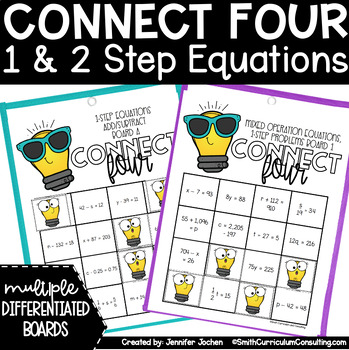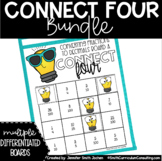Connect Four One-Step and Two-Step Equations Game Math Station Activity
- PDF
What educators are saying
Also included in
- Connect Four is a game that not only connects us to our childhood but also brings a sense of play into math practice. Within the Connect Four Bundle students will be able to practice various skills for fact fluency, computation, problem-solving, strategy, and more.Each Connect Four includes:Notes foPrice $35.00Original Price $80.25Save $45.25
Description
Connect Four is a game that not only connects us to our childhood but brings a sense of play into math practice. With Connect Four One-Step and Two-Step Equations students are given a one-step or two-step equation and must solve it using given operations.
Connect Four One-Step and Two-Step Equations includes:
- Notes for the Teacher (How to Set Up, Materials Needed, Photo in Use, etc.)
- Table of Contents
- Directions for How to Play (Color and Black and White)
- Chips for Players (Color and Black and White)
- EIGHT Different Connect Four One-Step and Two-Step Equations in Color and Black and White
- Answer Keys for all EIGHT One-Step and Two-Step Equations boards (add & subtract one-step equations, add & subtract two-step equations, multiply & divide one-step equations, multiply & divide two-step equations, all operation one-step equations, all operations two-step equations (x 2), and all-operations multi-step equations
- Recording Sheets for Student Work (Color and Black and White)
How Can I Use This?
Through the use of Connect Four games, you can easily set up a station during Math Workshop that swaps out the concept each week and not have to reteach the directions throughout the year allowing you to WORK SMARTER, NOT HARDER!
Connect Four One-Step and Two-Step Equations is also great for review, early finisher activities, enrichment, a worksheet alternative, partner activity, or as a take-home activity to encourage families to work together.
Interested in looking for other ways to play Connect Four in your classroom? Check out these other ways to implement this into your classroom with some FREE downloads for How to Play!
Looking for Other One-Step and Two-Step Equations Resources?
- Sixth Grade Expressions and Equations Homework Sheets
- Sixth Grade Expressions and Equations Interactive Notebook Lessons
- Seventh-Grade Expressions and Equations Interactive Notebook Lessons
- Writing Equations from Word Problems (Halloween)
- One-Step Equations Solve and Snip
- and Other Equations Products in my Store
→ Did you know that you can get CREDITS for future purchases by leaving feedback on each of your purchases? Simply navigate to the My Purchases page and next to each download, you will be able to leave a star rating and comments about the activities you have purchased. I truly value your feedback and consider each and every word left.
Personal Copyright: The purchase of this product allows you to use these activities in your personal classroom for your students. You may continue to use them each year but you may not share the activities with other teachers unless additional licenses are purchased. The license for this purchase is NON-TRANSFERABLE. Site and District Licenses are also available.
Copyright © Smith Curriculum and Consulting, Inc. All rights reserved.
DISCLAIMER: With the purchase of this file you understand that this file is not editable in any way. You will not be able to manipulate the lessons and/or activities inside to change numbers and/or words.






